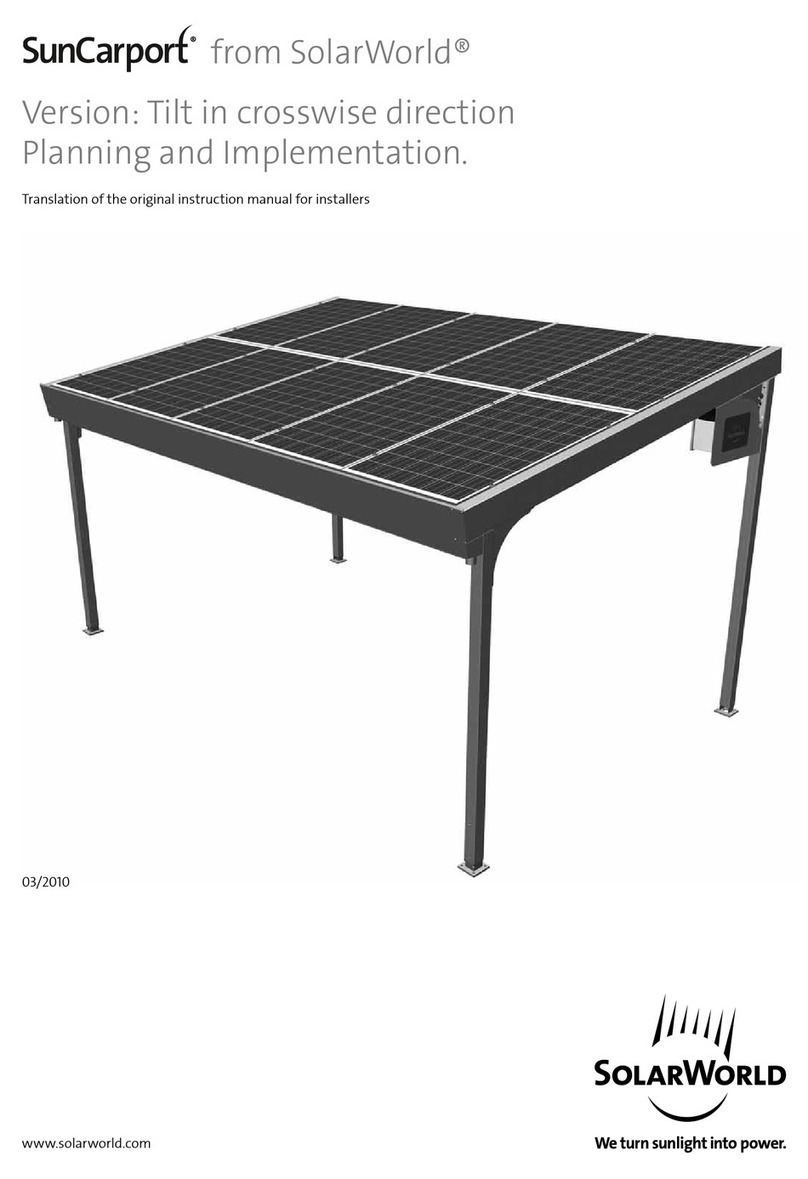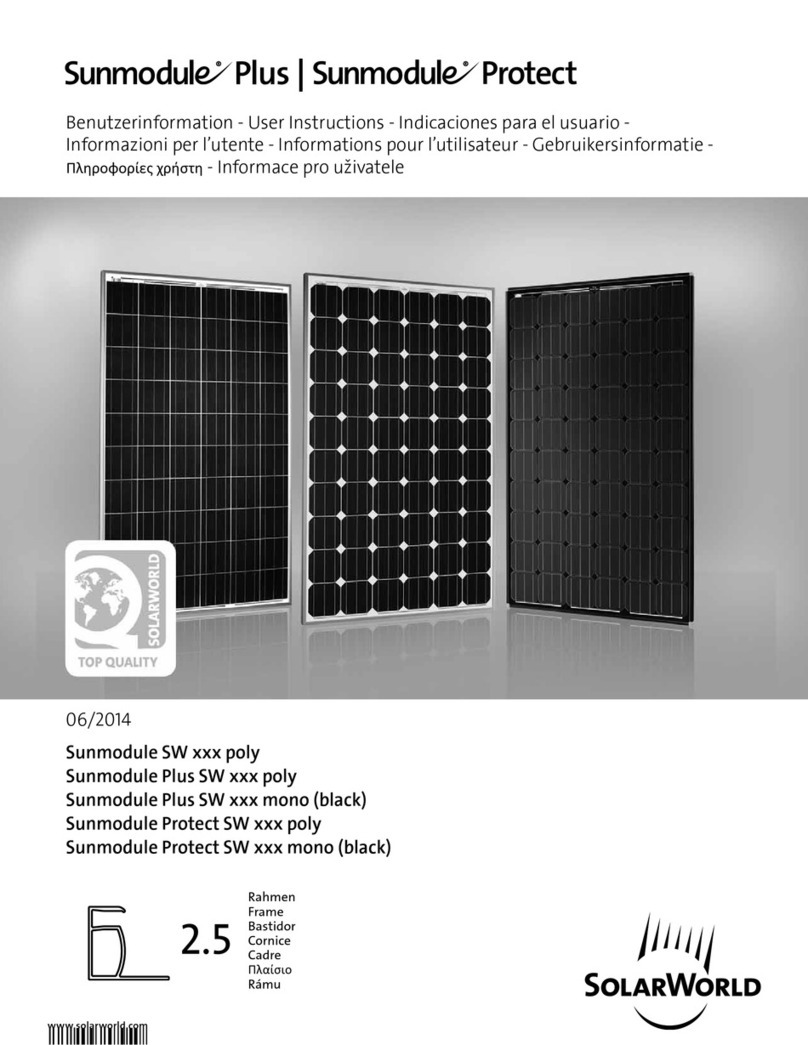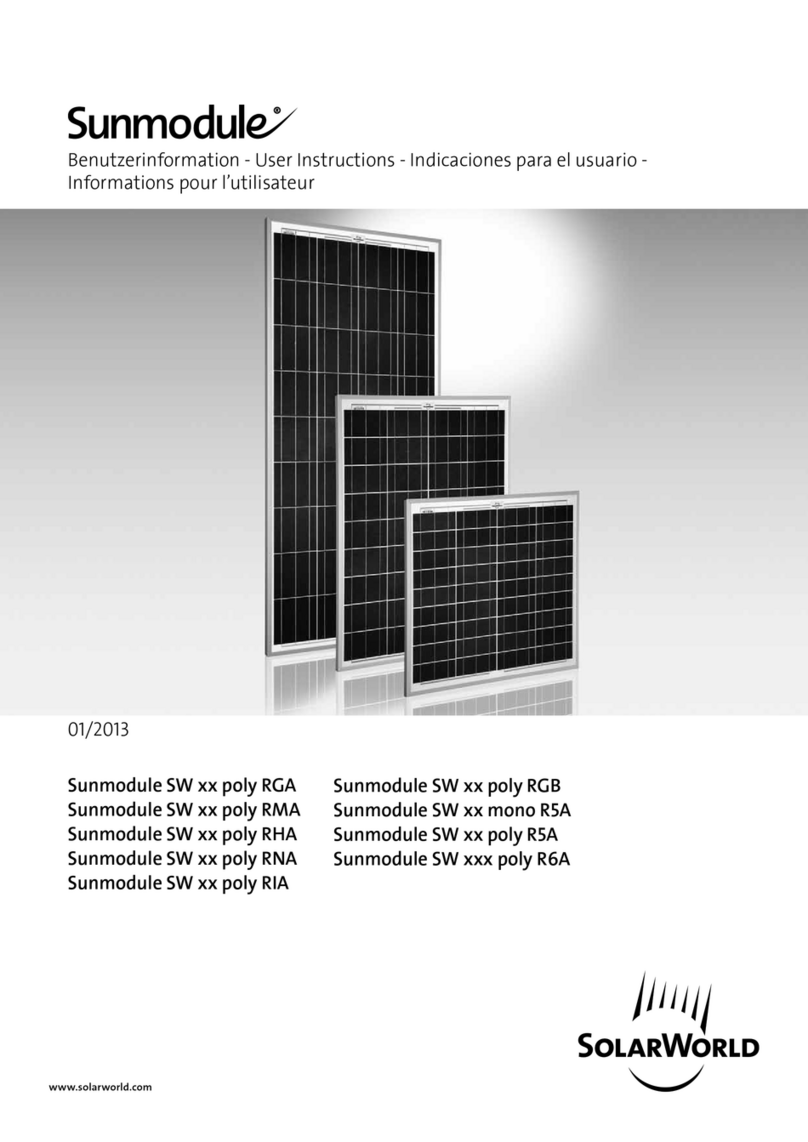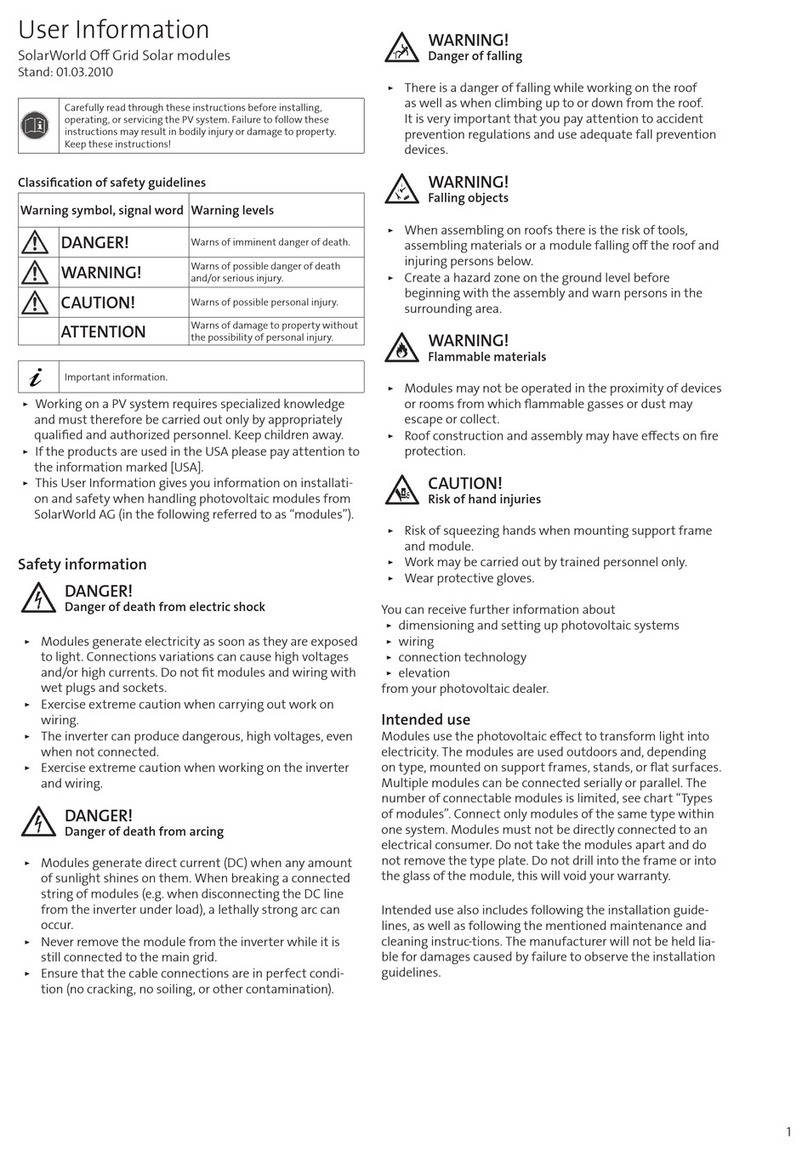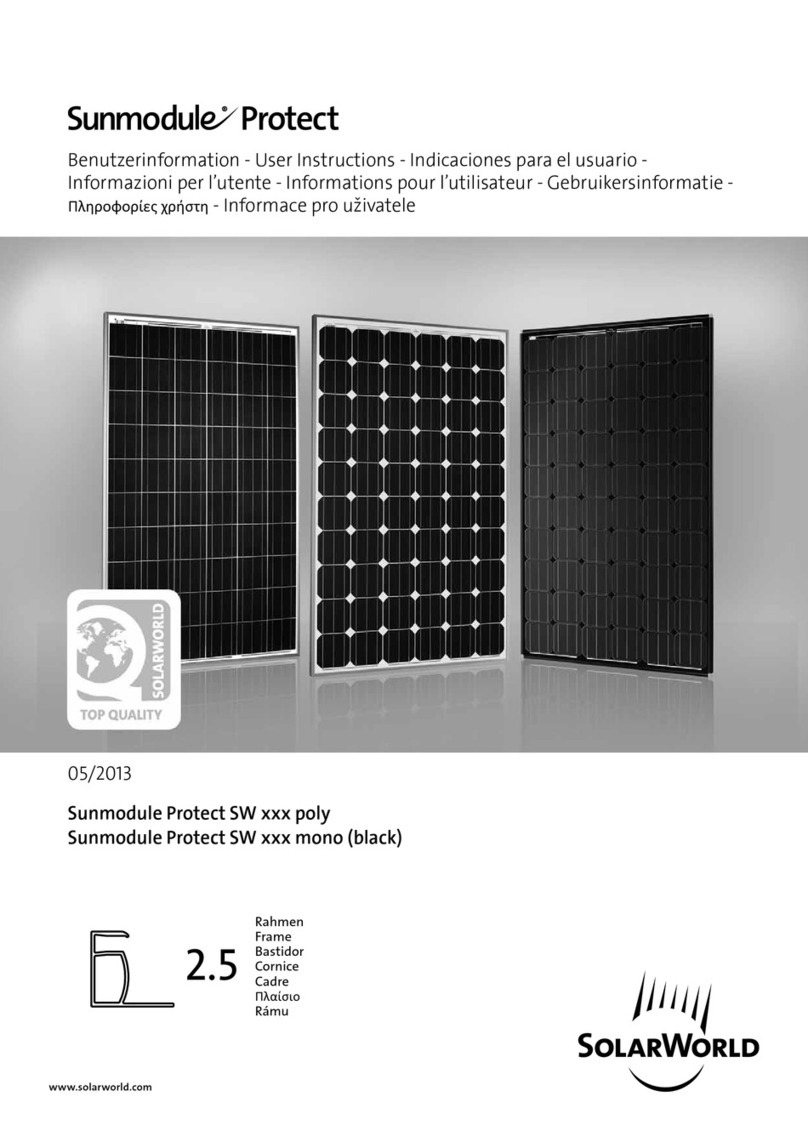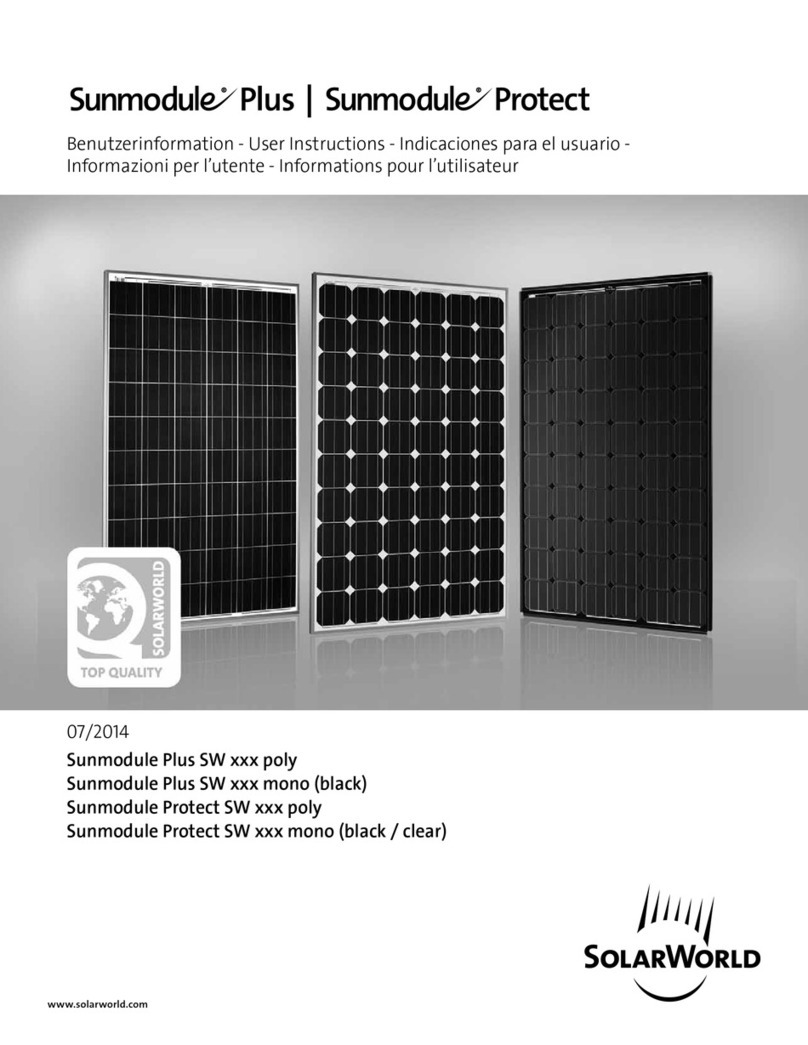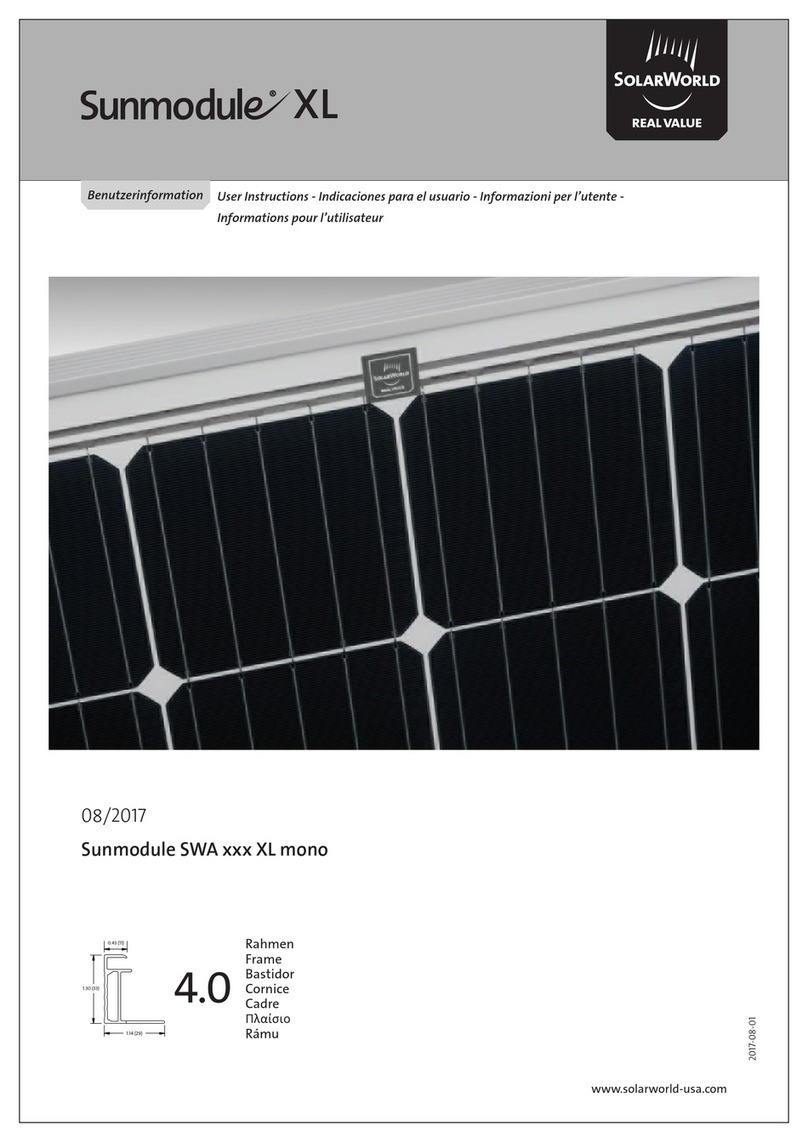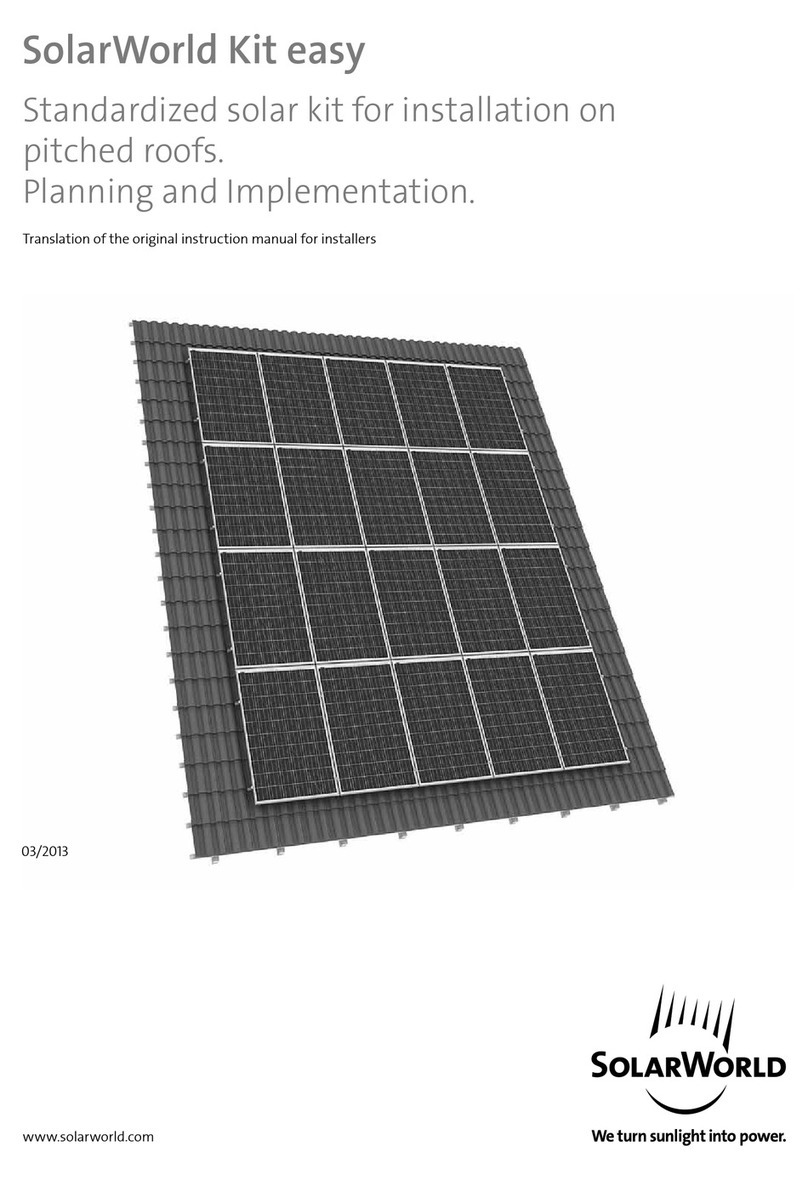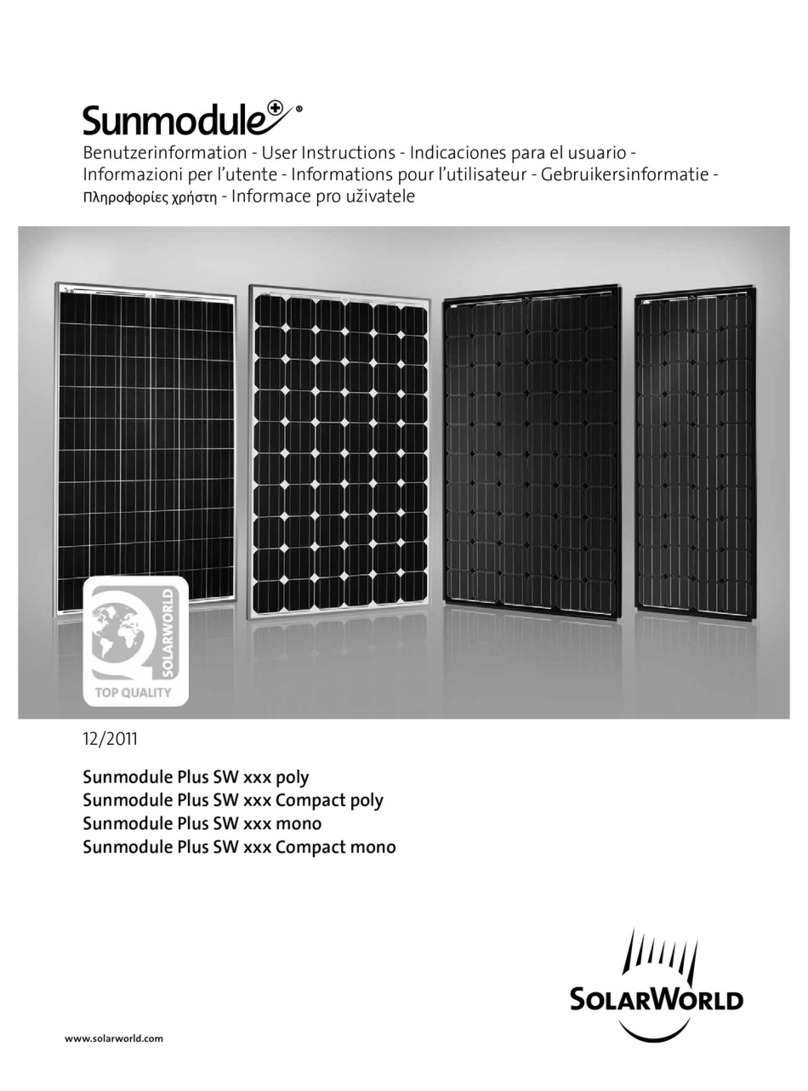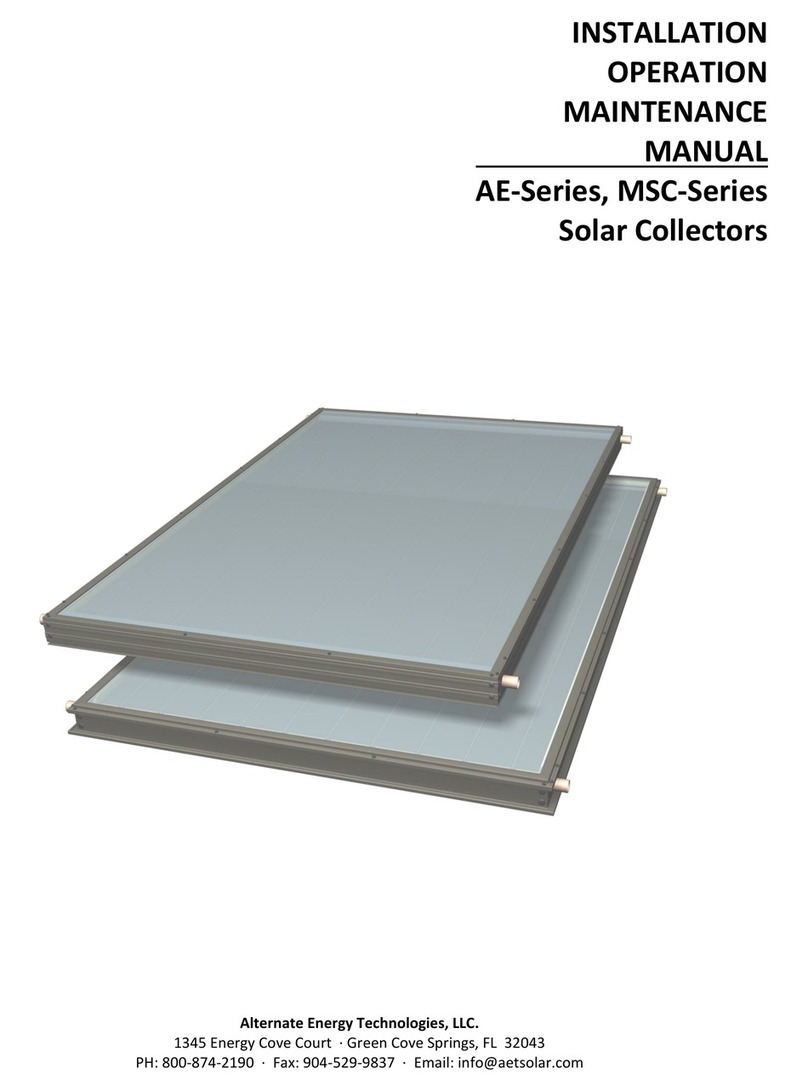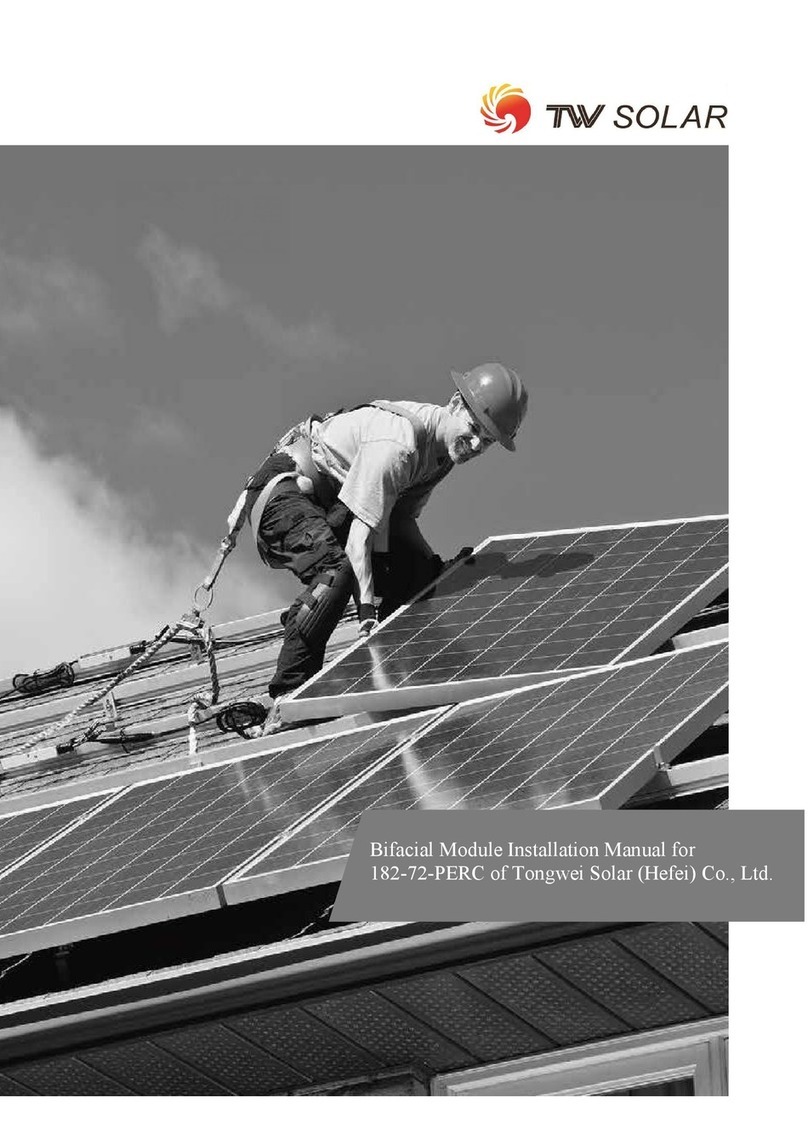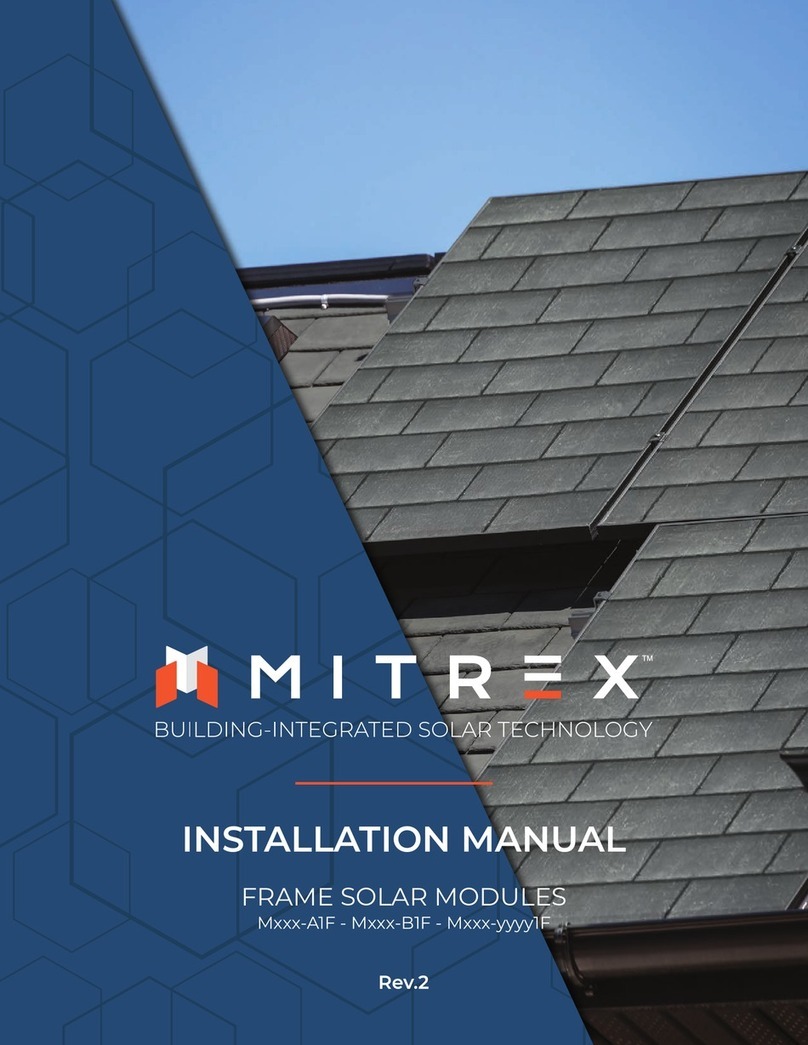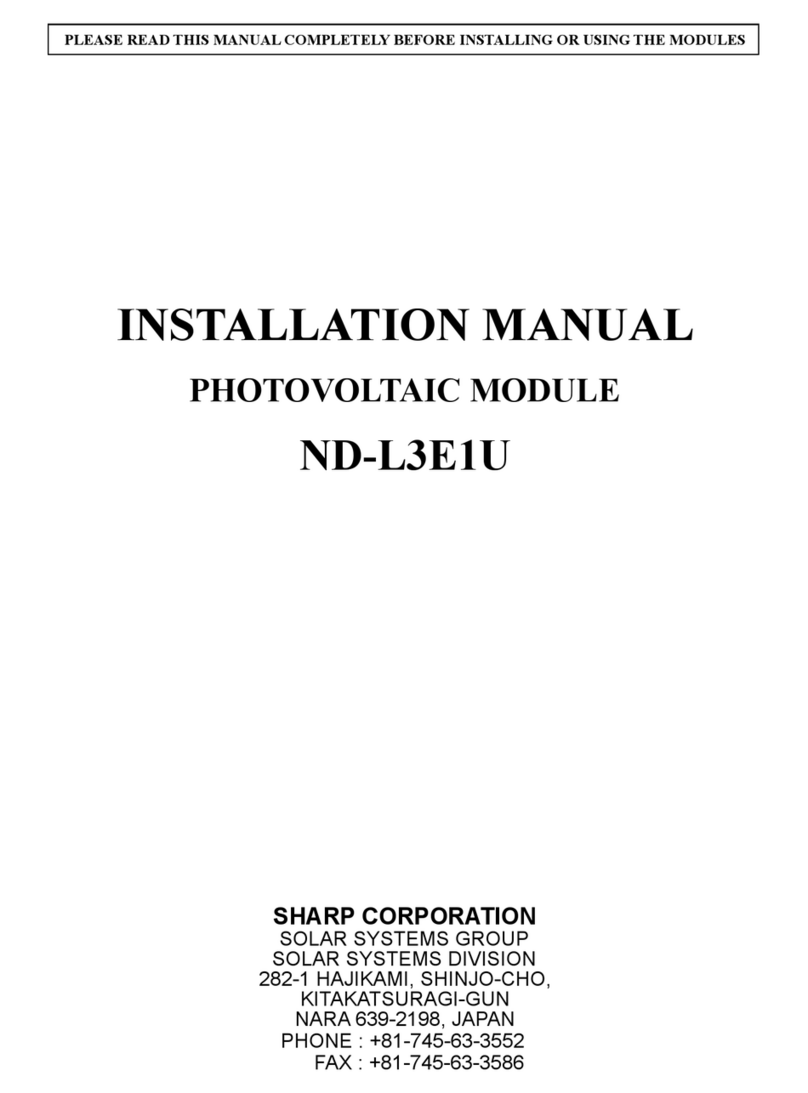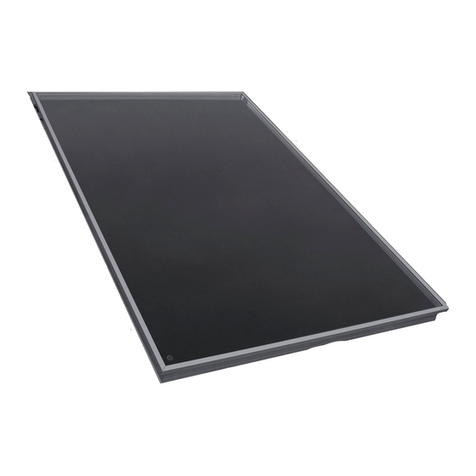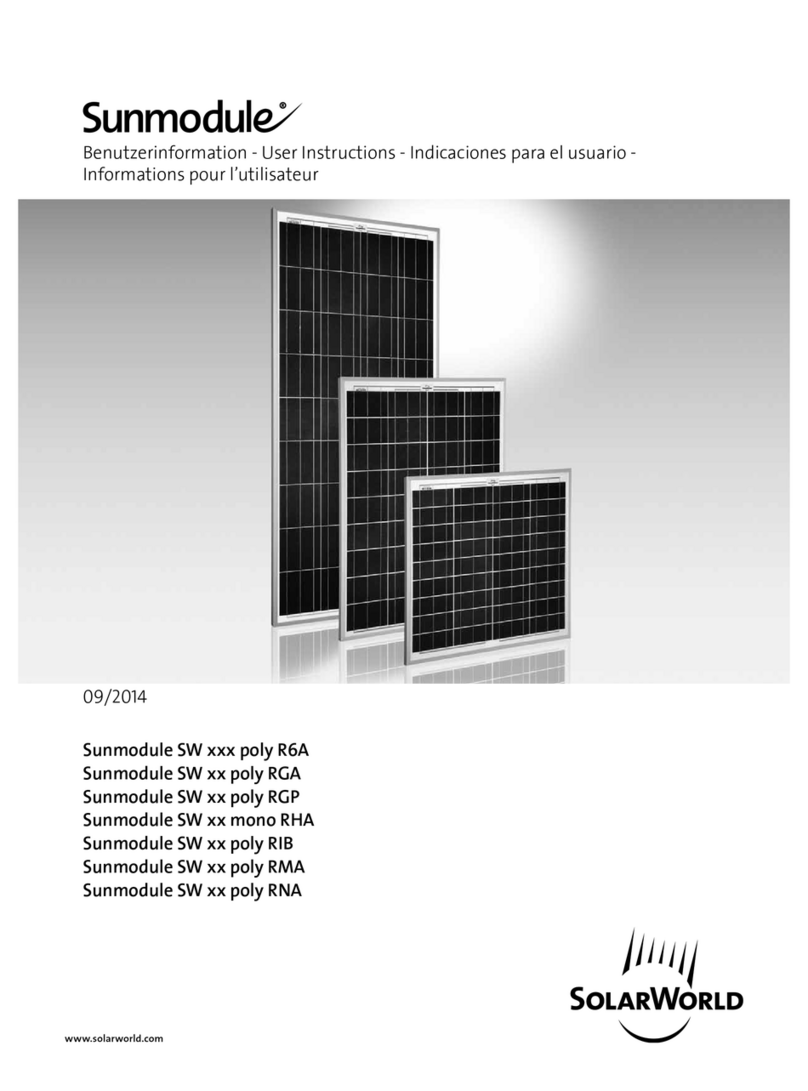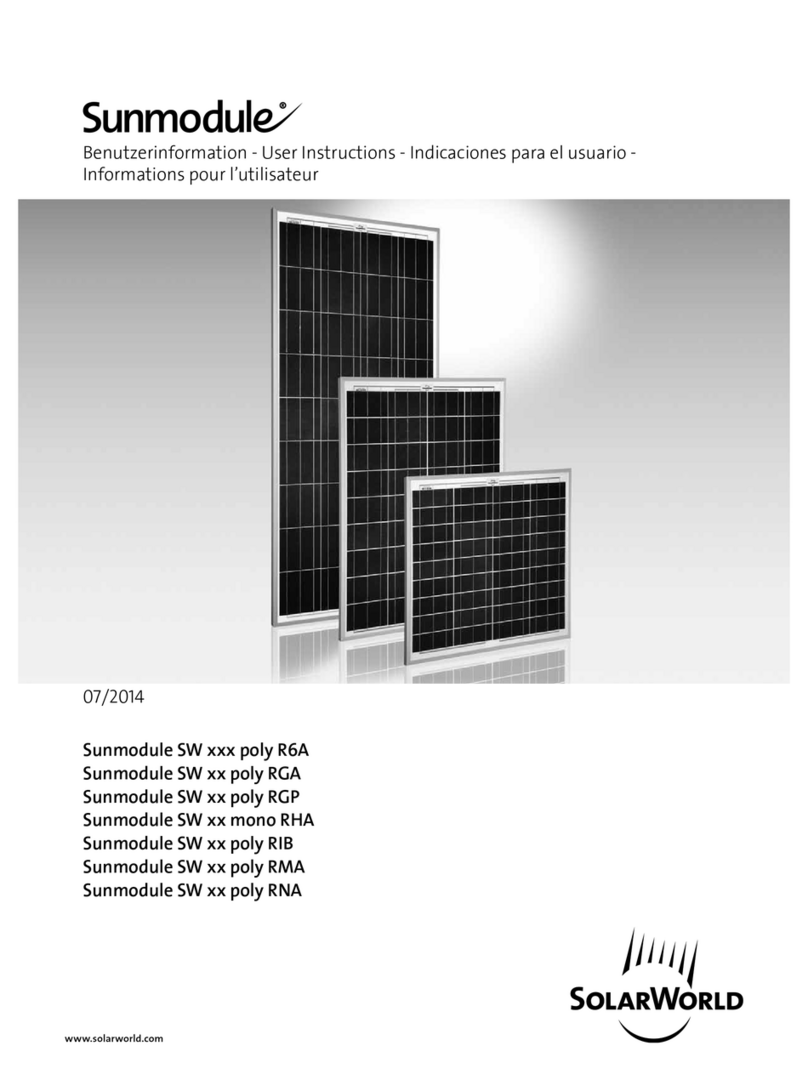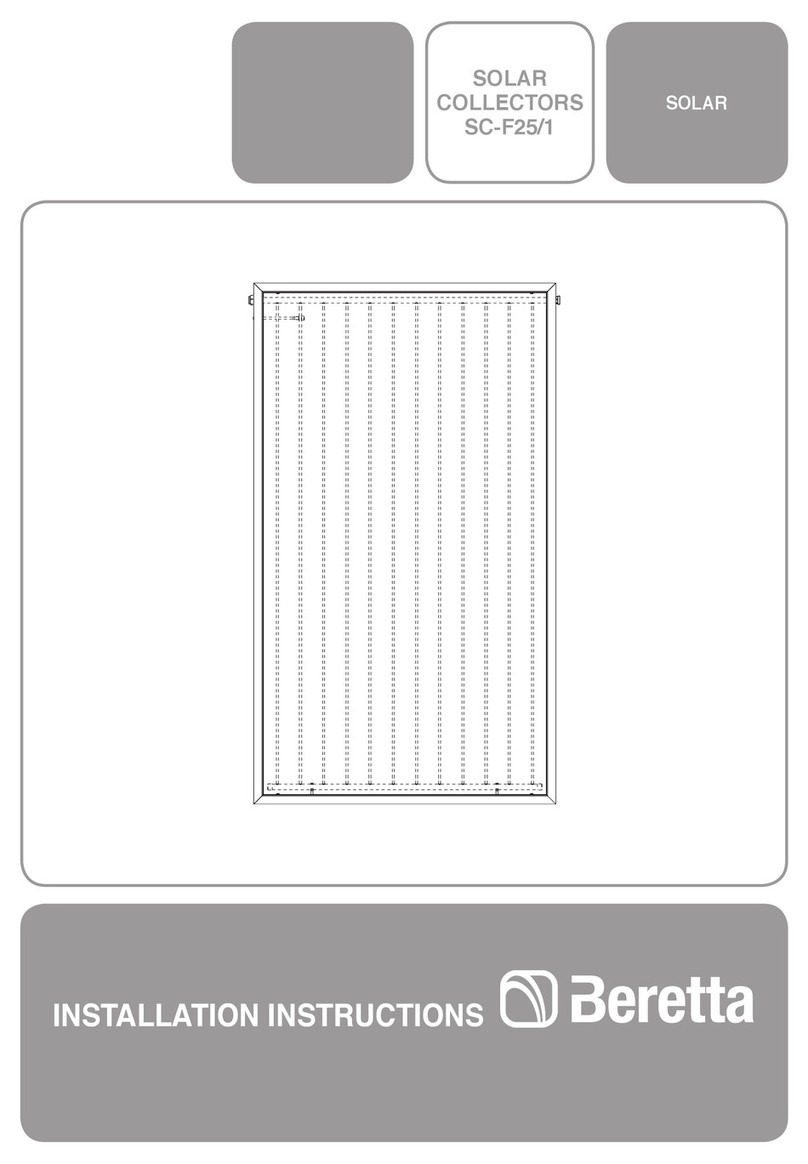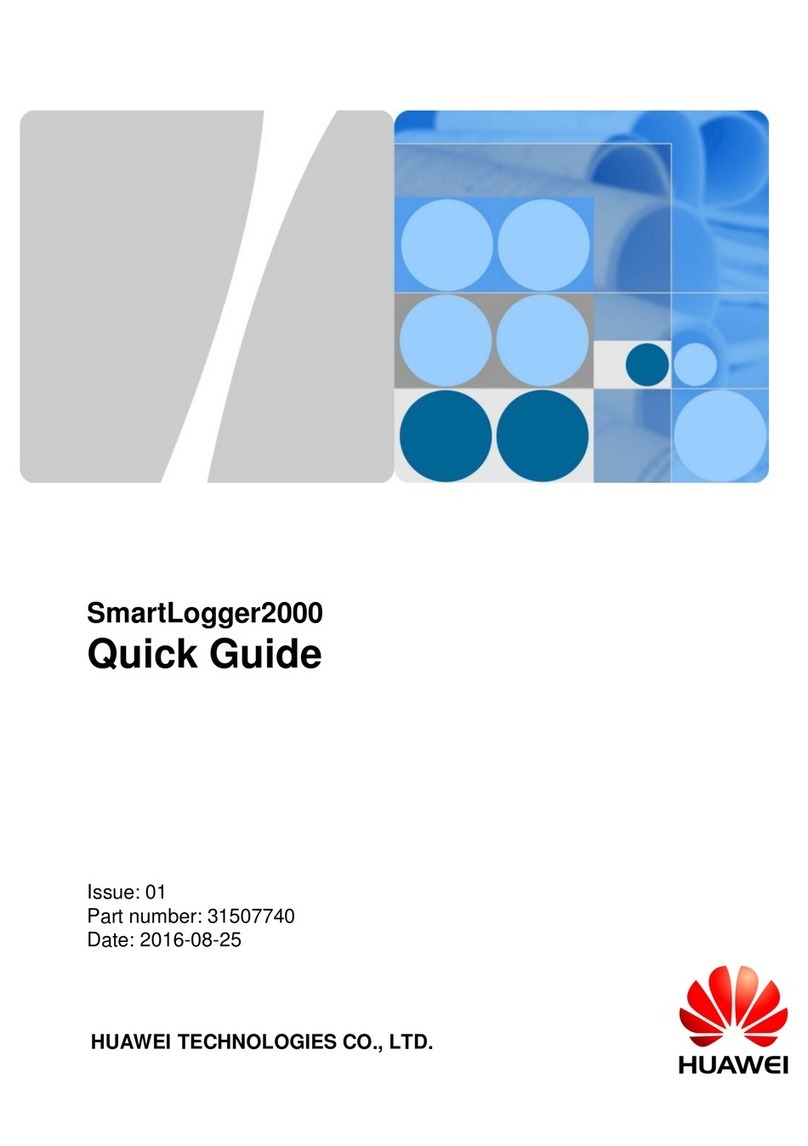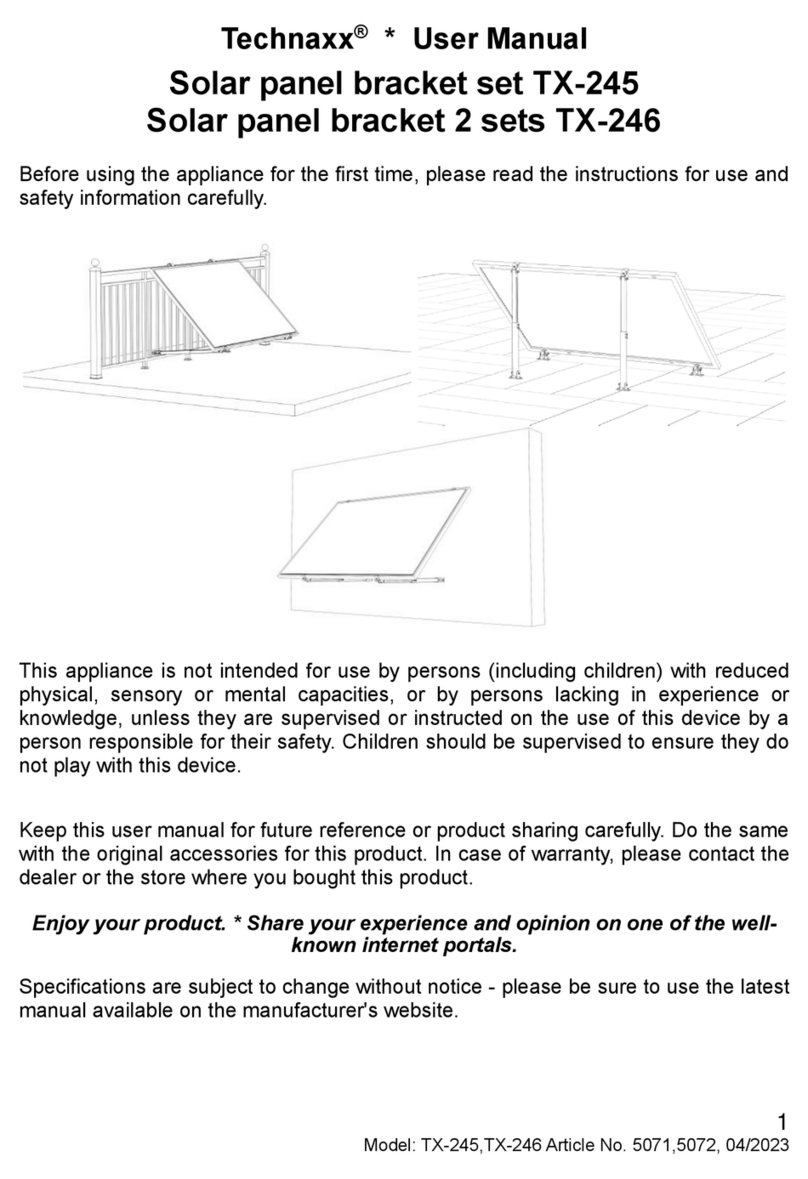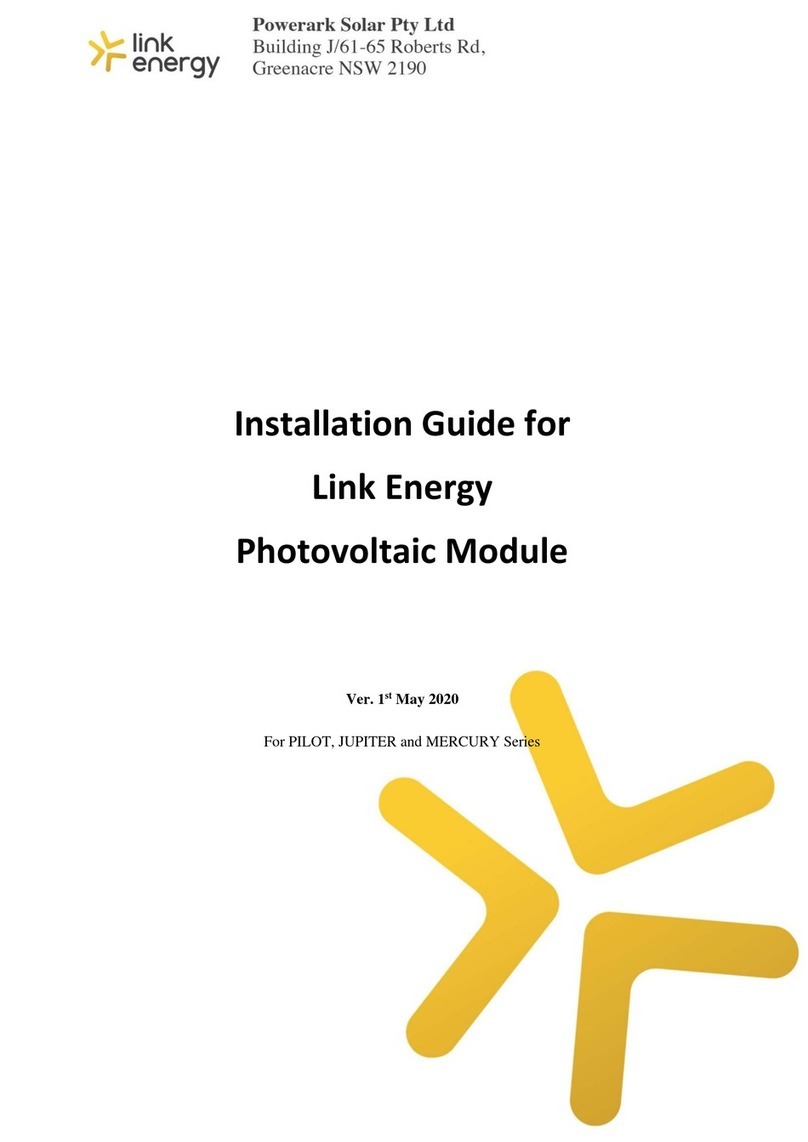•Grounding of the module nd fr me
Grounding V modules is necessary to reduce or eliminate shock and fire hazards.
The installer of a V system is responsible for grounding each module frame. It is
recommended to ground each module frame at the provided grounding holes (4mm
or 5/32 inch diameter, marked with the grounding symbol).
The ground connections between modules must be approved by a qualified electrician.
The main earth ground must only be connected by a qualified electrician. UL approved
grounding method is mandatory in the USA and Canada.
Ex mple A: (Not approved by UL)
The modules can be connected at the grounding holes using cables (16 mm2or 5AWG)
with cable lugs.To create the conductive connection (frame is anodized), use a bolt (M 4
or5/32 inch diameter) a serrated washer and a nut.
1)Cable lug 3) Serrated washer
2) Bolt 4) Nut
Ex mple B: (Approved by UL)
The modules can be connected at the grounding holes using a Lay-in lug and a bolt
with a serrated washer, a washer and a nut.
Dr wings:
Ground connection using a cable lug, a bolt,a serrated washer, a washer and a nut.
1) Lay-in lug 3) Serrated washer 5) Nut
2) Bolt 4) Washer
We recommend using the components as listed below. Any UL approved V grounding
method and components are also acceptable in the US and Canada.
T ble: Recommended components
Item Description M nuf cturer/ M nuf cturer
Distributor P rt Number
Grounding Lug Lay-In Lug Ilsco GBL-4
Bolt #6-32, SS McMaster Carr 92314A148
Serrated washer M5, SS McMaster Carr 91120A140
Washer ID 9/64’’, OD 3/8’’, SS McMaster Carr 92141A007
Nut #6-32, SS McMaster Carr 91841A007
• Fire s fety
The roof construction and installation may affect the fire safety of a building;improper
installation may contribute to hazards in the event of fire. For roof application, the
modules should be mounted over a fire resistant covering rated for the application.
The module is „non-explosion-protected equipment“. Hence it must not be installed in
the proximity of highly flammable gases and vapors (e.g. filling stations, gas containers,
paint spraying equipment).The module must not be installed near open flames or
flammable materials.
• Suit ble environment l conditions
The module is intended for use in temperate climatic conditions.
The module must not be subjected to concentrated light.It must not be immersed in water
or constantly exposed to water spray (e.g. from fountains). There is risk of corrosion with
exposure to salt (it is recommended that modules are installed at least 500 m or 1700 ft
from the sea) and sulfur (sulfur sources, volcanoes). The module may not be exposed to
extremely corrosive chemicals (e.g.emissions from manufacturing plants).
• Suit ble inst ll tion
Make sure the module meets the technical requirements of the system as a whole.Ensure
that other system components do not exert damaging mechanical or electrical influences
on the modules.When connected in series, modules must all have the same amperage.
When connected in parallel, the modules must all have the same voltage. The modules
must not be connected together to create a voltage higher than the permitted system
voltage. Modules must not be fitted as overhead glazing or vertical glazing (façade).
Ensure that the mounting system can also withstand the anticipated wind and snow
Crefully re d through these inst ll tion instructions before inst lling,oper ting or
servicing the photovolt ic (PV) system. F ilure to follow these instructions m y result in
bodily injury or d m ge to property. Keep these instructions! Working on PV system
requires speci lized knowledge nd must therefore be c rried out only by ppropri tely
qu lified nd uthorized personnel. Keep children w y!
W rning notices
D nger of de th from electric shock!
Solar modules generate electricity as soon as they are exposed to light. The
voltage of a single module is less than 50VDC. When several modules are connected in
series, the summed voltage can be dangerously high. When the modules are connected
in parallel the currents are summed together. Although touch protection is provided
in the form of the fully insulated plug contacts, the following points must be observed
when handling the solar modules to avoid the risk of fire, arcing and fatal electric
shock:
• The inst ll tion of higher volt ge systems should be done by qu lified, licensed
profession ls.
• Do not insert electric lly conducting p rts into the plugs or sockets!
•Do not we r met llic jewelry while performing mech nic l or electric l Inst ll tion.
• Do not fit sol r modules nd wiring with wet plugs nd sockets! Tools nd working
conditions must be dry.
•Exercise extreme c ution when c rrying out work on wiring nd use the
ppropri te s fety equipment (insul ted tools, insul ted gloves, etc.)!
• Do not use d m ged modules! Do not dism ntle modules! Do not remove ny p rt
or l bel fitted by the m nuf cturer! Do not tre t the re r of the l min te with p int,
dhesives or m rk it using sh rp objects!
D nger of de th from electric shock!
The inverter can produce dangerous, high voltages, even when not connected:
• Exercise extreme c ution when working on wiring nd the inverter.
• After switching off the inverter, it is essenti l to w it for the time interv l
specified by the m nuf cturer before beginning ny further work.
This llows the high volt ge components time to disch rge.
• Be sure c refully to follow the inverter m nuf cturer’s inst ll tion instructions.
D nger of de th from rcing!
Modules generate direct current (DC) when any amount of light shines on them.
When breaking a connected string of modules (e.g. when disconnecting the DC line from
the inverter under load), a lethally strong arc can occur:
• Never remove the sol r gener tor from the inverter while it is still connected to the
m in grid!
• Ensure th t the c ble connections re in perfect condition (no cr cking, soiling or other
cont min tion)!
Unp cking the modules nd stor ge
• Observe the w rnings on the p ck ging!
The utmost care is required when handling the modules. Take care when unpacking,
transporting, and storing them. Leave modules in packaging until they are to be installed.
Carry modules with both hands.Do not use the connection socket as a handle. Do not
stand modules on hard or rough ground. Do not stand modules on their corners. Ensure
modules do not bow. Do not place modules on top of each other. Do not subject to load,
do not stand on them, do not drop. Do not mark or work on them with sharp objects.
Keep all electrical contacts clean and dry. In order to keep a record of your system, we
recommend that you make a note of the serial numbers. If it is necessary to store the
modules temporarily, a dry, ventilated room should be used.
Gener l s fety inform tion
Ensure that the module is used for its intended purpose only. ay attention to the local
ordinances, building standards and accident-prevention regulations during installation.
The safety information for other system components must also be followed.
Inst ll tion
When installing the modules, please pay attention to:
• S fety during inst ll tion
Do not carry out installation work when there are strong winds. Secure yourself and
other workers to avoid falling. Secure work materials to prevent articles from falling.
Create a work zone to avoid accidents with other people.
• Keeping within the m ximum permitted lo d
Make sure the support structure adheres to maximum permissible load requirements as
prescribed by local ordinances, particularly in regions of high snow accumulations and
high wind velocities.Take notice to possible bowing of the modules under high loads.
Avoid installing fasteners,cable ties,etc. between the module backside and support
structure (i.e. on mounting rails) as any sharp edges can damage module.
Quick Guide for Users
SolarWorld® solar modules
Last revised: February 2008
Dr wing:
Bowing of the module under
high mechanical front loads.
Dr wing:
Ground connection using
a cable lug, bolt, serrated
washer and a nut
See: www.ilsco.com; www.mcmaster.com
4
3
2
1
5
3
4
2
1
Dr wing:
Grounding symbol


